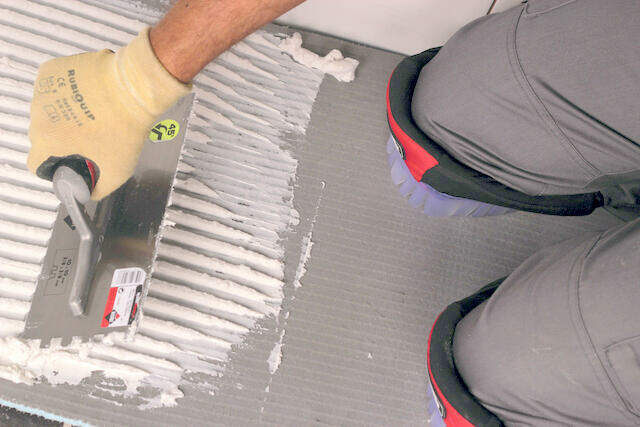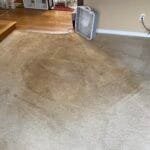When it comes to tiling projects, choosing the right materials is crucial. One decision you’ll face is selecting between modified thinset and unmodified thinset.
This choice can significantly impact the durability and appearance of your tiled surfaces. If you’re wondering which option is best for your project, you’re not alone. Many DIY enthusiasts and professionals alike grapple with this decision. We’ll break down the key differences, advantages, and potential drawbacks of each type.
By the end, you’ll have the clarity you need to make an informed decision, ensuring your next tiling project is a resounding success. Stick around to discover the secrets that could save you time, money, and future headaches.

Credit: m.youtube.com
Modified Thinset
Modified thinset contains added polymers for enhanced flexibility and bonding strength. Ideal for challenging substrates, it suits diverse tile installations. Comparatively, unmodified thinset requires additives for similar performance, often relying on external latex additives.
When tackling tile installation, choosing the right thinset is crucial. Modified thinset is a popular choice among professionals and DIY enthusiasts. It combines cement, sand, and special polymers. This mix offers enhanced performance compared to unmodified thinset. Let’s explore its composition, benefits, and ideal uses.Composition And Additives
Modified thinset includes cement, sand, and polymer additives. These additives improve flexibility and bonding strength. Polymers like latex or acrylic are common. They help in reducing water absorption. This makes it more durable in wet conditions. The result is a thinset that adheres better to various surfaces.Advantages Of Use
Modified thinset offers several key advantages. It provides better adhesion to surfaces. This ensures tiles stay in place longer. The flexibility of modified thinset prevents cracks. This is especially useful in areas prone to movement. It also sets quicker, saving time on projects. Its water resistance makes it ideal for wet areas.Ideal Applications
Modified thinset works well in many settings. It is perfect for bathroom and kitchen tile installations. Wet environments benefit from its water resistance. It is also suitable for outdoor projects. This includes patios and walkways. Modified thinset supports a variety of tile materials. From ceramic to natural stone, it’s a versatile choice.Unmodified Thinset
Unmodified thinset is a fundamental choice for tile installation. It consists of basic ingredients that provide reliable bonding. Known for its simplicity, it suits many standard projects. Understanding its uses can help in choosing the right thinset for your needs.
Basic Ingredients
Unmodified thinset contains Portland cement, sand, and water-retaining agents. These elements create a sturdy base for tiles. It lacks polymers, which are found in modified thinset. This makes it a more traditional option. Its composition ensures durability and strength.
Benefits In Certain Scenarios
Unmodified thinset is ideal for projects with controlled conditions. It performs well in areas with stable temperature and humidity. It is often chosen for indoor installations. This thinset offers a dependable bond for tiles without additional additives. Its simplicity can be advantageous in specific applications.
Typical Uses
Unmodified thinset is often used for ceramic and porcelain tiles. It is suitable for floors and walls where moisture is not a concern. It serves well in residential settings with standard requirements. Many professionals prefer it for basic tile installations. Its straightforward application appeals to those familiar with traditional methods.
Key Differences
Choosing the right thinset for your tile project is crucial. Modified and unmodified thinset each have unique properties. Understanding their key differences will help you decide which is best for your needs. Let’s delve into the performance, setting, curing times, moisture, and flexibility.
Performance Comparison
Modified thinset contains polymers that enhance its adhesive strength. This makes it ideal for high-traffic areas. Unmodified thinset lacks these additives. It performs well in areas with less stress. Modified thinset provides better bonding with challenging surfaces. Unmodified thinset excels in simple applications. Both types offer reliable performance under suitable conditions.
Setting And Curing Times
Modified thinset sets faster due to added polymers. It cures quickly, allowing faster project completion. Unmodified thinset takes longer to set and cure. This slower process is suitable for projects needing adjustments. Modified thinset is great for time-sensitive installations. Unmodified thinset requires patience but offers precision.
Moisture And Flexibility
Modified thinset is more flexible and moisture-resistant. It adapts to temperature and humidity changes. This makes it perfect for outdoor or wet areas. Unmodified thinset is less flexible and moisture-resistant. It suits indoor environments without drastic climate changes. Modified thinset offers versatility in various conditions. Unmodified thinset provides stability in controlled settings.
Choosing The Right Thinset
Choosing the right thinset can make or break your tiling project. Whether you’re a seasoned contractor or a DIY enthusiast, understanding the differences between modified and unmodified thinset is crucial. The right choice depends on several factors, including the type of project, environmental conditions, and budget considerations. Let’s dive into these aspects to help you make an informed decision.
Project Type Considerations
Consider the surface you’re working on. Modified thinset is ideal for areas prone to moisture, like bathrooms and kitchens. It offers better adhesion, preventing tiles from popping off.
Unmodified thinset, however, shines in dry areas. It works perfectly for indoor installations where moisture isn’t an issue. If you’re laying tiles over a concrete slab, unmodified is your go-to option.
Think about the tile type. Porcelain and natural stone may require modified thinset for enhanced bonding. On the other hand, ceramic tiles can work well with unmodified thinset in dry settings.
Environmental Factors
Take into account the climate where you live. Modified thinset is often more resilient in fluctuating temperatures. It’s engineered to withstand freeze-thaw cycles, making it ideal for outdoor use.
In humid regions, modified thinset can prevent mold growth and tile movement. If your project is in a basement or a damp area, consider modified thinset for its moisture-resistant properties.
For projects in stable, dry conditions, unmodified thinset provides a solid, reliable base without the extra additives. It’s perfect for interior spaces that remain dry year-round.
Cost And Availability
Budget is always a concern. Modified thinset is typically more expensive due to its enhanced features. However, the investment can be worthwhile for its durability and versatility.
Unmodified thinset is usually more affordable, making it a great choice for large projects on a tight budget. It’s widely available and can be used in many indoor applications without compromising quality.
Consider local availability. Depending on your region, one type may be more accessible than the other. Check with local suppliers to ensure you get the best product for your needs.
Have you ever faced a tiling disaster because of the wrong thinset choice? Share your stories or tips in the comments below. Your experiences could help others avoid costly mistakes!
Common Mistakes
Mixing modified and unmodified thinset is a common error. Each type has specific uses and benefits. Ensure the right choice for your project to avoid problems.
When working with tiles, choosing between modified and unmodified thinset can be tricky. However, common mistakes often lead to problems that could have been easily avoided. Proper usage ensures longevity and effectiveness. Let’s explore some of these errors and how you can steer clear of them.Incorrect Mixing
Mixing thinset properly is crucial. Too much water can weaken its strength, while too little can make it difficult to apply. Always aim for a peanut butter-like consistency. I once rushed through mixing, and the result was a thinset that set unevenly. This mistake cost me time and effort. Measure carefully and mix thoroughly to avoid this pitfall.Inappropriate Application
The right application technique is key. Using the wrong trowel size or failing to apply the thinset evenly can lead to tiles popping up or cracking. Consider the tile size and surface when choosing your tools. An uneven application not only ruins the aesthetic but also the functionality.Ignoring Manufacturer Instructions
Manufacturers provide instructions for a reason. Ignoring these guidelines can lead to a poor finish or even failure of the tiling job. I learned this the hard way when I skipped reading the label on a new type of thinset. It resulted in a botched application. Remember, those instructions are there to guide you. What common mistakes have you encountered in your DIY projects? Reflecting on these can save time and resources in future endeavors.
Credit: m.youtube.com
Expert Recommendations
Choosing between modified and unmodified thinset depends on the tile and substrate type. Modified thinset offers flexibility and strength, ideal for challenging surfaces. Unmodified thinset is preferred for certain installations, such as with cement backer boards. Each has unique benefits tailored to specific projects.
When deciding between modified and unmodified thinset, expert recommendations can be invaluable. These insights help ensure you choose the right adhesive for your tiling project. Understanding the nuances of each can save you time and potential hassle.Professional Insights
Experts in the field often suggest modified thinset for most home projects. Its added polymers enhance flexibility and adhesion, making it suitable for a variety of surfaces. You might find it especially helpful if you’re tiling over plywood or other non-cement surfaces. On the other hand, unmodified thinset is typically recommended for projects involving cement backer boards. Professionals highlight its pure cement content, which provides a strong bond as it cures. It’s also often required for certain types of tile installations, like those using large porcelain tiles.Tips For Optimal Results
Mixing Matters: Always follow the manufacturer’s instructions for mixing thinset. Proper consistency ensures better application and adhesion. Surface Preparation: Ensure your surface is clean and level. This reduces the chance of tiles lifting or cracking later on. Application Technique: Use the right trowel for your tile size. This helps in spreading the thinset evenly, ensuring full coverage and preventing air pockets. Curing Time: Allow sufficient curing time before grouting or walking on the tiles. Rushing this can compromise the bond strength. Have you ever experienced tiles popping off unexpectedly? It’s often due to improper curing or surface prep. Taking the time to do it right initially can prevent costly repairs down the line. Which thinset will you choose for your project? Consider your surface, tile type, and environment. The right choice can make all the difference in the longevity and appearance of your tiling work.
Credit: www.rubi.com
Frequently Asked Questions
What Is The Difference Between Modified And Unmodified Thinset?
Modified thinset includes polymers for better adhesion and flexibility. Unmodified thinset is just cement, sand, and water retention agents.
Can I Use Unmodified Thinset For Porcelain Tiles?
Yes, unmodified thinset can be used for porcelain tiles. It works well with the right substrate.
Is Modified Thinset Better For Outdoor Use?
Yes, modified thinset is better for outdoor use. It handles temperature changes and moisture well.
Do I Need To Add Anything To Unmodified Thinset?
No, you do not need to add anything. It is ready to mix with water.
Which Thinset Is More Water-resistant?
Modified thinset is more water-resistant. Its polymers help prevent water penetration.
Conclusion
Choosing between modified and unmodified thinset matters. Each has unique benefits. Modified thinset offers flexibility and strength. It’s ideal for challenging installations. Unmodified thinset is perfect for traditional projects. It bonds well with dense materials. Consider your project’s needs carefully.
Think about environmental conditions. Also, assess substrate type. Both options ensure durable tile installation. Make a choice based on your specific requirements. Proper selection ensures lasting results. Now you’re ready to make an informed decision. Your tile project will be successful.
Enjoy the process and your beautiful new space!





